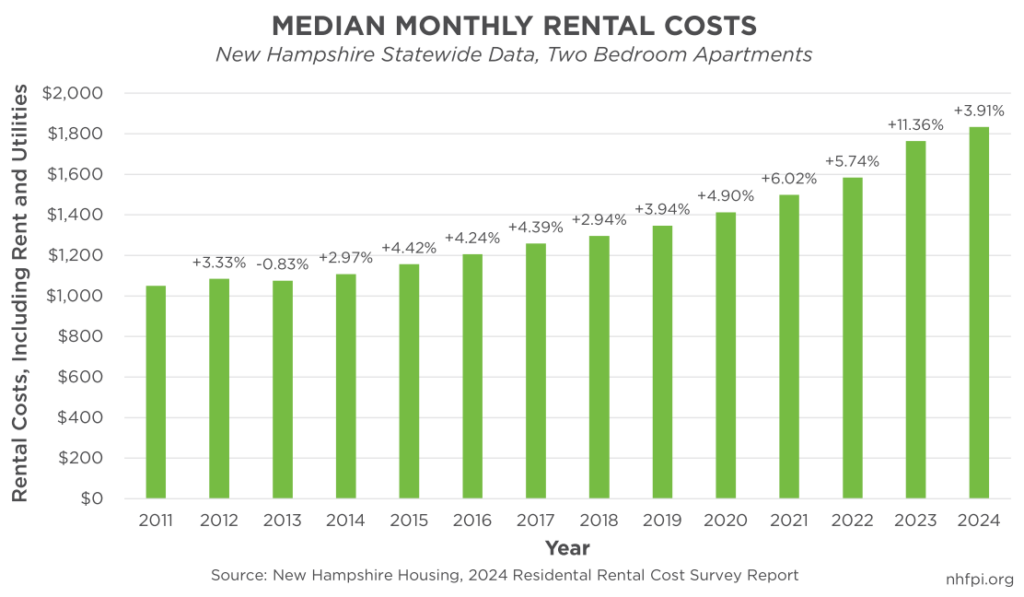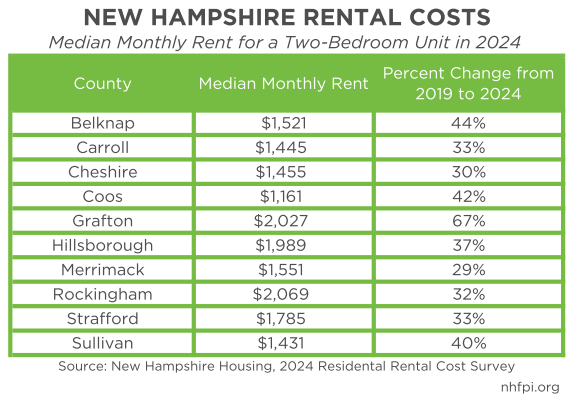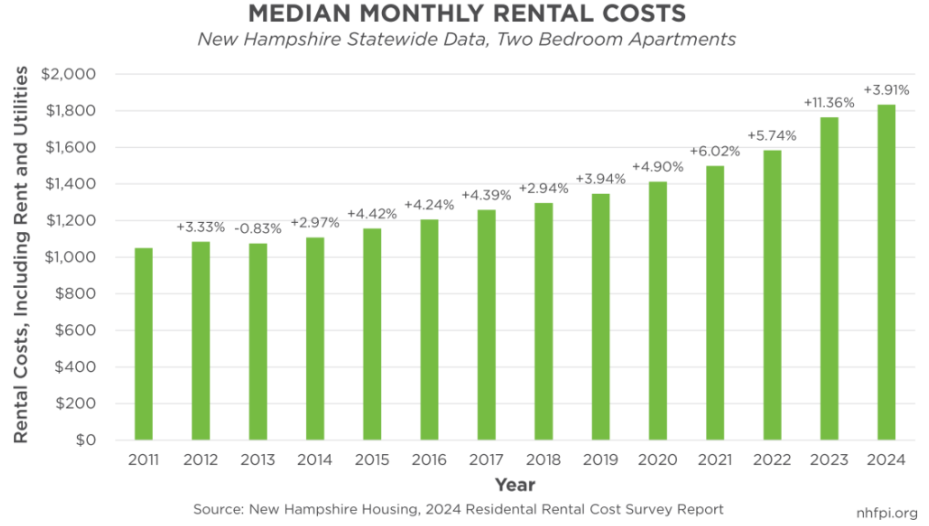New data collected earlier this year show the cost of renting continues to rise in New Hampshire, increasing pressure on overall housing availability and the finances of Granite State renters. The median price for a rental unit in New Hampshire reached a record high of $1,691 in 2024. Moreover, as of July 2024, the median price for a single-family house in the state increased to $530,000, the highest it’s ever been. Rising housing costs and limited inventory can create barriers to safe and affordable housing for Granite State families and individuals, as well as create other challenges associated with transportation and access to services. Increasing costs for both renters and homeowners have contributed to the hardships facing households across the state, especially among renters with low and moderate incomes. Compounding these challenges, renters may face difficulty affording the rising costs of living and may be less likely to transition to the housing market to purchase a home.
Increased Costs Across the State
According to the 2024 Residential Rental Cost Survey Report based on data collected between March and May 2024 and published by New Hampshire Housing, the State’s housing finance authority, the median monthly rent across all rental units in the Granite State, including utilities, was $1,691. For a two-bedroom unit, the median cost was $1,833 per month, an annual increase of about 3.9 percent from 2023, which was slightly higher than the average of 3.3 percent annual inflation faced by consumers in New England overall during this period.

While rental prices have been rising since 2014, cost increases slowed between 2023 and 2024 compared to the annual change the year prior. From 2022 to 2023, the median monthly rent for a two-bedroom unit rose by about 11.4 percent, in part due to increases in the cost of utilities. In 2024, the median cost of utilities for a two-bedroom unit where the tenant pays for heat was $266 a month, a decline of about 15.6 percent from the median cost of $315 in 2023. Decreased utility costs in 2024 may explain the smaller overall monthly rental cost increase relative to the change in total costs from 2022 to 2023.
Rental prices across the Granite State have increased at a rapid pace since the start of the COVID-19 pandemic. In 2019, a two-bedroom unit cost $1,347 a month, which increased by about 31 percent by 2024. The declining availability of rental units shortly before the start of the pandemic is likely a key factor influencing the increase in prices over the last few years. After spiking to 1.8 percent in 2020, the vacancy rate for two-bedroom rental units declined to 0.6 percent in 2021. While the rate has fluctuated each year since then, the vacancy rate for a two-bedroom unit in 2023 (0.6 percent) remained lower than 2019 pre-pandemic levels (0.8 percent). According to New Hampshire Housing, the vacancy rate needed to create a balanced rental market is 5 percent, which was last achieved for rental units in the state overall in 2010.
Regional variations in supply and demand for housing impact median monthly rental costs. The 2024 median price for a two-bedroom unit ranged from the highest price of $2,069 per month in Rockingham County to $1,161 per month in Coos County. Coos, Carroll, Cheshire, and Sullivan Counties had median rental costs lower than $1,500 per month for a two-bedroom unit, and the state’s remaining six counties all had higher prices. While rental costs have risen in all ten counties, increases have been unevenly distributed across the state. From 2019 to 2024, the median price of a two-bedroom unit increased by about 67 percent in Grafton County, the largest percentage increase across all counties. According to New Hampshire Housing, rising costs in Grafton County were driven by rents in the areas of Lebanon and Plymouth. Comparatively, Merrimack County experienced the smallest percentage increase, about 29 percent, during this period. Rising rental costs in certain parts of the state may impact where families can afford to live, having further implications for the availability of necessary resources, such as child care and health care services. Additionally, higher housing costs can prevent individuals and families from moving to certain areas for employment opportunities, leading to labor force constraints.

Implications of the Current Rental Market
Rising housing costs increased financial strain on Granite Staters with low and moderate incomes. As of 2022, the median household income for homeowners in the state was almost double that of renters, at about $108,000 and approximately $56,000, respectively. According to New Hampshire Housing, only about 24 percent of rental units in 2024 were affordable to those making the renter median household income of $56,814. Based on wage data analyzed by New Hampshire Housing, out of 11 selected high-demand occupations, only nurses had median wages sufficient to afford rent and utilities for a two-bedroom unit in the state. Further, public school teachers and electricians were the only occupations that could afford a one-bedroom unit based on median wages, while all other high-demand occupations, such as nursing assistants and construction laborers, earned median monthly wages lower than the median price for a one-bedroom unit. Renters are also more likely to pay more than 30 percent of their income towards housing costs, the amount defined by the U.S. Department of Housing and Urban Development as being cost-burdened by housing that functions as a simple but reliable measure of affordability. According to U.S. Census Bureau data from 2018 to 2022, nearly half of renters in the Granite State were cost burdened by housing prices. Among those with a household income less than $35,000, about three out of four were paying more than 30 percent of their income towards rent.
The increase in housing costs may have some association with the rise in eviction filings across the state, as more New Hampshire families with low incomes may face difficulty paying rent. According to the Eviction Lab at Princeton University, about 4.3 evictions were filed for every 100 Granite State renter households in 2018. This rate was more than double the rate in neighboring Vermont (2.1), as well as higher than both Maine (2.8) and Massachusetts (3.5) that year. The total number of eviction writ filings in New Hampshire increased by about 66 percent from 3,742 filings in 2020, encompassing a temporary eviction moratorium in New Hampshire followed by federally-funded rental assistance, to 6,221 in 2023. The 2023 total was similar to 2019 pre-pandemic numbers (6,514 filings). The increase in evictions may have contributed to the rise in homelessness. From January 2022 to January 2023, the number of unhoused people in New Hampshire increased by about 52 percent, according to the U.S. Department of Housing and Urban Development’s point-in-time estimates.
The rise in prices across the rental market is not independent of the challenges experienced in the housing market as a whole. According to the New Hampshire Association of Realtors, as of July 2024, the median price of a single-family house in New Hampshire was $530,000, an increase of 76.7 percent from the median price of $300,000 in July 2019. According to Harvard University’s Joint Center for Housing Studies, a family purchasing a house in Hillsborough County would need an annual income of about $156,000 to afford a median-priced house. A median income-earning family that could have afforded a house in 2019 may face difficulties buying one in 2024. Additionally, due to the limited availability of single-family houses, households that can afford a house may need to remain in rental housing longer, potentially resulting in fewer rental units available for families and individuals unable to afford to buy a house. As the median single-family house price continues to rise, renters with low and moderate incomes in the Granite State will likely struggle to keep up with rising housing costs.
– Jessica Williams, Policy Analyst





